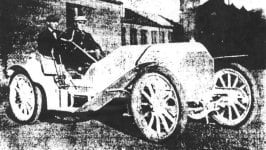Mr Washington Augustus Roebling II was born in Trenton, Mercer, New Jersey on 25 March 1881.
He was the son of Charles Gustavus Roebling (b. 1849) and Sarah Mahon Ormsby (b. 1856) and was named for his father's eldest brother, Washington Augustus Roebling (1837-1926), an American Civil War veteran and civil engineer whose best known work included the Brooklyn Bridge.
His father was born in New Jersey to German immigrants, his own father, John Augustus Roebling (1806-1869) having founded John A. Roebling & Sons engineering company and linked with the world's first modern steel suspension bridges. A graduate of Rensselaer Institute, proprietor of a wireworks and Vice President of his father's company until his death, Charles was married to his Pittsburgh-born wife Sarah, known as Sallie, on 25 January 1877.
Washington had three known siblings: Harrison Ormsby (1877-1883), Emily Margaretta (1880-1941, later Mrs Richard McCall Cadwalader) and Helen (1885-1963, later Mrs Carroll Sergeant Tyson II). He had at least two other siblings who died as small infants. He first appears on the 1885 census, still living in Trenton. His mother passed away on 15 January 1887 and his father never remarried.
Roebling graduated first from the State Model School and then from the Hill School in Pottstown, Pennsylvania with a degree in engineering. While in school, he was noted for his skills in football. After working for a time at his father's business (the Roebling Wire Company), he began work at the Walter Automobile plant which was later taken over by the Mercer Automobile Company, Mercerville. While at the Mercer plant he designed and built his Roebling-Planche racing car, finishing in second place in the Vanderbilt Cup Race in Savannah, Georgia in 1910.


Left: Washington A. Roebling
Right: "Washington A. Roebling, II, at the wheel of the specially built Roebling Planche racer, which, after having been designed and built under the direction of young Roebling, was entered and driven by him in the Vanderbilt Cup Race at Savannah two years ago."
In early 1912, he left on a tour of Europe with his friend Stephen Weart Blackwell, also of Trenton. Roebling's chauffeur, Frank Stanley accompanied the two men, bringing with them Roebling's Fiat car. They toured Italy and France, and it was in France that they met up with the George Dennick Wick family. It was on the voyage to Europe, they also become acquainted with a member of the Wick party, Miss Caroline Bonnell. However, a week before the completion of their trip, Stanley fell ill and returned to the USA on another ship, bringing the Fiat back with him.
Roebling and Blackwell boarded the Titanic at Southampton as first class passengers. Roebling carried ticket no. PC 17590 (£50 9s 11d) and occupied cabin A-24.
On the night of 14 April, according to Edith Graham and her daughter Margaret, Roebling alerted them to the danger and with the help of Howard Case, escorting them to the lifeboats and making no attempt to enter themselves. Caroline Bonnell said Roebling also helped her and the women in the Wick party into a lifeboat, during which he said cheerfully, "you will back with us on the ship again soon."
Roebling and Blackwell both perished, however, there was some confusion over Roebling's fate when an early list of survivors listed a Mr Washington. This was later determined to refer to Dr Washington Dodge who escaped with his wife and son.
Upon receiving word of the sinking, two cousins of Roebling, Ferdinand W. Roebling, Jr. and Karl Roebling left for New York with Blackwell's two brothers. After failing to find their relatives among the survivors arriving on the Carpathia, and talking with Ms Bonnell, the relatives realised the men's fate and returned to Trenton.
After the chauffeur Stanley's return to America, the Fiat car, the only remnant of the men's ill-fated journey was driven back home by relatives. What became of it remains a mystery.
His father Charles, a prominent member of the Trinity Episcopal Church in Trenton, later had the west wall of the cathedral rebuilt as a memorial to his son. Having never recovered from the death of his son, he died on 5 October 1918 and was buried in Riverview Cemetery in Trenton.


Comment and discuss
-
I was trying to find out if Washington Augustus Roebling II, who died on the Titanic, was the son or grandson of John Augustus Roebling who built the Brooklyn Bridge. I read somewhere that Washington Augustus Roebling who was the son of John, died in 1926. So Washington Augustus II must have been the grandson. Can you confirm this? Joanne Caravello New Jersey
-
I have done a good bit of research on the Roebling family (for a variety of reasons) and it aggravates me that no Titantic site EVER elaborates on 1st class passenger Washington Roebling. I will provide you with the materials that I have collected over the years. Washington was the grandson of John Roebling, the patriarch of the famous bridge-building family, and Washington's entire clan was wealthy and civic-minded. They erected a sizeable monument in Washington's memory in Riverview, the same Trenton cemetery where almost all of his family is buried. Wendy Miller Nardi Trenton, NJ
-
Roebling, Mr Washington Augustus 2nd (FROM YOUR PASSENGER LIST) Are you aware he was the namesake and nephew of the builder of the Brooklyn Bridge? (I'm just a bridge nut) Jim McFarland PENNSYLVANIA
-
I would like to suggest a minor correction to the entry for: Washington Augustus Roebling II In the second paragraph, the name of the family business in Trenton NJ is given incorrectly. The correct name was: John A. Roebling Sons Co. not Roebling Wire Co. Signed Donald Sayenga
Open Thread Leave a Reply